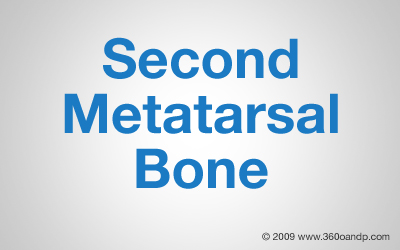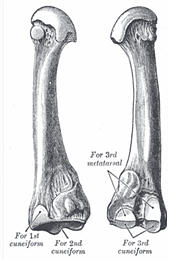

The second metatarsal bone is the longest of the metatarsal bones, being prolonged backward into the recess formed by the three cuneiform bones.
Its base is broad above, narrow and rough below.
It presents four articular surfaces: one behind, of a triangular form, for articulation with the second cuneiform; one at the upper part of its medial surface, for articulation with the first cuneiform; and two on its lateral surface, an upper and lower, separated by a rough non-articular interval.
Each of these lateral articular surfaces is divided into two by a vertical ridge; the two anterior facets articulate with the third metatarsal; the two posterior (sometimes continuous) with the third cuneiform.
A fifth facet is occasionally present for articulation with the first metatarsal; it is oval in shape, and is situated on the medial side of the body near the base.
The second metatarsal base acts as a "keystone (architecture)" (like in an arch) for the lisfranc joint.
The base of the metatarsal is held firmly between the 1st & 3rd cuneiform.
Injuries
The Beckham bone is a name attributed by British journalists to the second metatarsal.
David Beckham, while playing for Manchester United against Deportivo La Coruña in a UEFA Champions League quarter-final game in 2002, was subject to a tackle from Argentina's Aldo Duscher. (A lot of acrimony had existed between David Beckham and Argentina since David Beckham's sending off in the 1998 World Cup). This tackle broke the second metatarsal in his left foot and seriously threatened England's chances in the 2002 World Cup. David Beckham was the media darling at the time, and the bone (and the tackle) received a wave of publicity; subsequently, the name "Beckham bone" was born.
Since then, other notable football superstars including, Gary Neville, Danny Murphy, Michael Owen, Gael Clichy, Ashley Cole, Ledley King, Mikael Silvestre and Lionel Messi have suffered fractures to the same 2nd metatarsal bone.